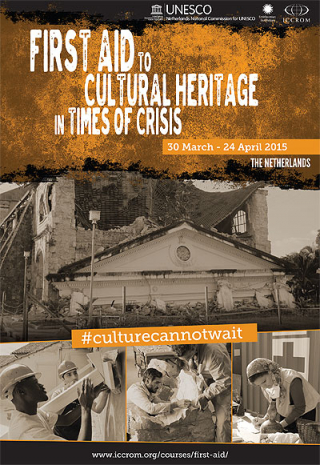Is it possible to save cultural heritage from the intentional targeting that we are witnessing in Syria and Iraq? In the aftermath of large-scale natural disasters such as Cyclone Pam, how can cultural heritage be recovered quickly and effectively?
Over the next four weeks, 21 professionals from risk-prone areas such as Gaza, Guatemala, Haiti, Philippines, Syria and Ukraine will convene in Amsterdam to participate in the international course on First Aid to Cultural Heritage in Times of Crisis, jointly organized by ICCROM, the Smithsonian Institution, the Netherlands National Commission of UNESCO, and 11 national institutions including the Netherlands Ministries of Culture and Education.
This is the fourth international course on First Aid, organized within the framework of ICCROM’s multi-partner programme on disaster risk management.
First Aid to Cultural Heritage in Times of Crisis aims to equip proactive cultural “first aiders” with the necessary skills and knowledge to work with communities and other mainstream emergency actors to protect cultural heritage amidst an unfolding crisis situation.
“Culture cannot wait, the credo of the First Aid training stems from the idea that for communities uprooted by disasters, culture in its both tangible and intangible forms, provides a thread of continuity and helps in overcoming the trauma of loss and displacement, therefore, it cannot be separated from humanitarian assistance”, says Aparna Tandon, the course leader and ICCROM Project Specialist.
The training is multidisciplinary and has inputs from other emergency actors such as military and humanitarians. Simulated emergency events, role-playing and group discussions will help in developing leadership skills. The training will encourage participants to play a key role in creating initiatives for disaster risk management of cultural heritage in their respective countries.
Post-training, a limited number of seed grants will be offered, and a closed call for proposals will be made to the course participants. The aim will be to use knowledge obtained from this course to strengthen capacities for disaster risk management of cultural heritage at regional levels.
Who is a Cultural First Aider?
A Cultural First Aider is a person who has the necessary knowledge and skills to document and protect cultural heritage during a complex emergency. She/he is:
- proactive yet sensitive to human needs
- respectful of the local context
- capable of building trust and understanding amongst people who have different views
- able to develop and implement first aid operations for protecting cultural heritage in coordination with other relief agencies
- able to constitute and manage teams
- capable of assessing and mitigating future risks in order to ensure early recovery
First Aiders in action: find out how former participants are making a difference in the world

